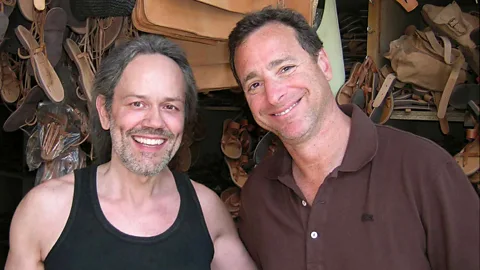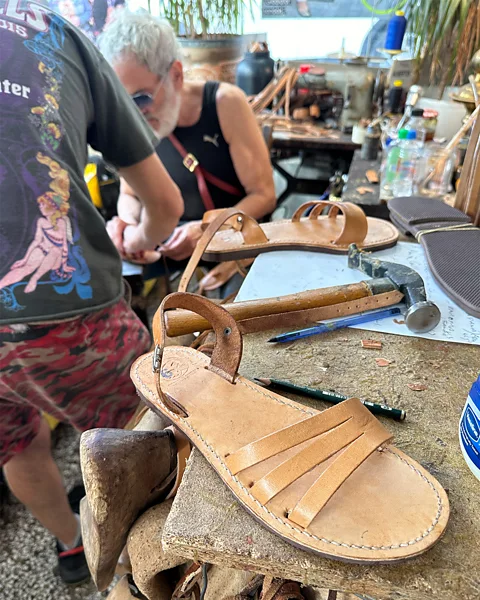The Athens workshop where celebrities shop
 Courtesy of Pantelis Melissinos
Courtesy of Pantelis MelissinosAt the foot of the Acropolis, one family has been handcrafting leather sandals for more than a century, fitting the feet of Sophia Loren and John Lennon. Now, a new generation is reinterpreting the family's legacy of bespoke footwear.
Before Athens had hundreds of souvenir shops, it had the self-appointed "Poet Sandal Maker". A craftsman and writer of poetry, Stavros Melissinos was the first modern cobbler to adapt Ancient Greek-style leather sandals into fashion-forward everyday footwear. By the mid-1950s, his designs had caught on among the jet-set crowd crisscrossing Europe. Sophia Loren stopped by to have a pair of sandals made while filming Boy on a Dolphin in Greece. Then came Ingrid Bergman, Jacqueline Kennedy Onassis and John Lennon, who discovered the humble workshop at the foot of the Acropolis while visiting Greece in search of an island to buy. Melissinos inherited the shop, originally opened in 1920 by his father and uncle, and transformed it into a hub for art, literature and creative leatherwork.
As I sit in the eclectic Melissinos Art – The Poet Sandal Maker atelier, I can't help but think of the many famous faces who have passed through these doors. In the early 2000s, Melissinos retired and passed the torch to his son, Pantelis, a playwright and artist in his own right. Part studio, part stage, the space is filled with relics of celebrity visits: a signed headshot of Sarah Jessica Parker to my right; a photo of Pantelis with Bob Saget to my left; and a catalogue of sandal styles bearing names like "The Maria Callas" and "The Jeremy Irons" in front of me. As Pantelis custom-fits a pair of Spartan sandals for a woman from Charleston, South Carolina, his white dog Poy-Poy curls up in an antique armchair beside a hand-painted, abstract-style coffee table that wouldn't be out of place in the MoMA. Customers don't just come for the sandals. They flock here for a distinctly Greek experience.
After all, sandals have long been a symbol of status and craftsmanship in Greece. The word sandal is derived from the Greek sandálion, with depictions of the footwear appearing in myths like that of Hermes, the messenger god often portrayed with winged sandals. Worn by philosophers, actors and warriors alike, these traditional sandals – often made from leather and cork – embodied the intersection of utility and fashion in Ancient Greece, with various styles reflecting the wearer’s gender, age and even social status in the community.
When Stavros began crafting Ancient Greek-style sandals, which at the time were primarily used in theatrical performances, for everyday wear, it helped propel his shop into the international spotlight long before people discovered the poet’s sandals via social media.
 Julia Eskins
Julia Eskins"Back then, everything spread through word of mouth," says Pantelis. Mykonos was booming, thanks in part to frequent visits by Greek shopping magnate Aristotle Onassis, his wife, Jackie, and their entourage of luminaries like Elizabeth Taylor and Maria Callas. "When people saw these icons wearing our sandals, it created a ripple effect that brought international attention to our small shop."
One of the most legendary brushes with fame came in 1967 when The Beatles dropped by. "My older brother was just 13 at the time and happened to be there," says Pantelis. "He was such a huge fan that he nearly had a heart attack seeing his idols being fitted for sandals. Later, I asked my father why he didn't get their autographs… He simply said, 'They should have gotten my autograph instead.' That moment perfectly captures his quiet confidence."
Stavros used the shop not just as a place to craft sandals, but also as a platform for sharing the poetry that he wrote. It was this artistic combination that drew visitors in and made the experience impossible to replicate, even though the shop has had its fair share of copycats over the years.
Stavros is now in his 90s, but the shop's cachet hasn't faded. Recently, Pantelis made sandals for the Bidens. "At first, I didn't recognise them," he says. "It was only when Ashley Biden introduced herself that it clicked. Suddenly, I realised the workshop had been quietly surrounded by Secret Service."
On any given day, the atelier attracts a small crowd of people eager to get their hands on a pair of his handmade sandals. Pantelis, who draws inspiration from Ancient Greek mythology and modern art, uses full-grain, vegetable-tanned leathers from Crete to create pieces like the minimal double-strap Socrates and Diogenes sandals. The natural-coloured leather darkens to a rich brown over time – a patina that can be sped up with baby oil or Vaseline. Each pair takes about 30 minutes to make, though wait times vary depending on how busy the shop is. Pantelis compares the atmosphere to a "spontaneous little party", especially during Greece's high season between May and October.
 Courtesy of Olgianna Melissinos
Courtesy of Olgianna MelissinosBut not far away, another workshop also carries the family name, though its approach is slightly different.
While Pantelis inherited the original sandal shop, his younger sister, Olgianna, carved her own path with Olgianna Melissinos Sandals. "I wanted to continue the legacy, but on my own terms," she says. Though her father never formally taught her his craft, she absorbed his techniques during summers spent working in the family shop and opened her atelier in 2004. "One day, when I was watching my hands working, it was like a choreography of my dad's hands," she says. "But after a certain point, you create your own choreography."
How to visit:
• Melissinos Art – The Poet Sandal Maker is on the corner of Diakou and Tzireon, less than a 10-minute walk from the Acropolis.
• To purchase sandals, customers must visit the workshop in person to be fitted and place their order (credit cards, cash, Apple Pay and Google Pay are accepted). You don’t need to make an appointment, but fittings can take anywhere from 30 minutes to two hours or longer depending on the model.
• The shop is open Tuesday to Saturday from 10:00 to 18:00
• Sandals start at €150
That natural instinct, paired with her focus on comfort and elegance, has earned her a loyal clientele, some of whom make her shop their first stop after touching down in Athens. Her approach includes giving guests the option to create brightly coloured or metallic leather sandals in addition to the classic natural-hued ones.
Part of what motivates Olgianna is the desire to make every person feel good. She recalls designing a pair of sandals for a woman in her 50s who wasn't happy with the way her feet looked in open-toed shoes. "She came to the shop in tears and said, 'I walked about 3km in your shoes and this is the first time in my life that I actually felt elegant'," says Olgianna. "I got emotional, too."
For Olgianna, sandal-making is as much about people as it is about craft. "They remember the experience and the conversation."
 Julia Eskins
Julia EskinsThat human connection is one of the driving forces behind more travellers seeking out handcrafted mementos rather than touristy trinkets. According to Expedia's travel trends report for 2025, nearly half of surveyed travellers say they now prioritise locally made specialty items they can't purchase at home.
"People are often surprised by how vibrant and creative the Greek design scene is," says Agathi Kefala, an Athens-based guide who leads shopping tours through Withlocals. "There's a deep sense of pride in the craftsmanship, and guests can actually see the process, hear the stories and connect with the maker."
More like this:
• Is it time to change how we buy travel souvenirs?
After constantly being asked for shopping recommendations from friends and family, Kefala saw an opportunity to share some of her favourite spots that are not typically found in guidebooks. Today, she leads travellers to shops specialising in handmade ceramics, leather goods, linen clothing, olive oil, honey and organic skincare. Since launching her tours in 2018, she's seen firsthand the rising interest in craft shopping experiences.
Still, the preservation of these traditions isn't guaranteed. "The factories that once supplied us with rubber and other materials have either closed down or are in the process of closing," says Pantelis.
While sourcing materials locally is becoming more challenging, the story may not end with this generation. Olgianna is hopeful this millennia-old tradition will continue for generations to come. In a city shaped by myths and legends, the Melissinos name still holds its weight. And for travellers seeking a souvenir with a story, these Athenian sandals are nothing short of wearable poetry.
--
If you liked this story, sign up for The Essential List newsletter – a handpicked selection of features, videos and can't-miss news, delivered to your inbox twice a week.
